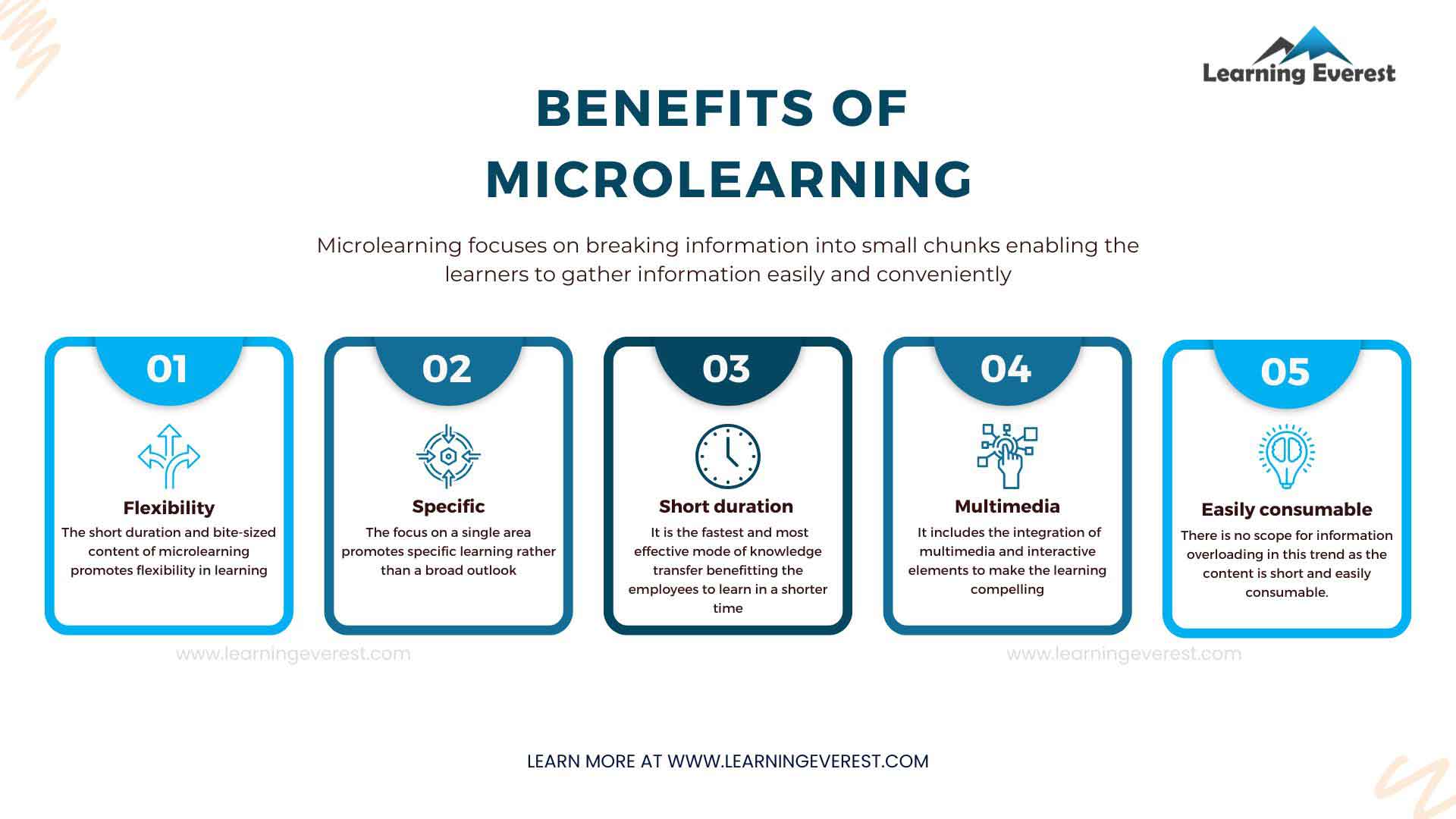Learning and Development trends are rapidly evolving along with the advancements in technology and diverse workforce needs. With the growing demand in the Learning and development sector, it is crucial to identify and implement the latest trends for enhancing employee skills and achieving organizational goals. If you’re a professional seeking to comprehend top learning and development trends, you’ve found the right spot. This blog discusses top learning and development trends beneficial for workplace training. Keep reading!
Table of Contents
Why Adopting Different Learning and Development Trends Matters
Learning and Development is a crucial component within an organization that aims to improve the efficiency of the employees by conducting training programs, preparing learning strategies aligning with organizational goals, promoting career progression opportunities, and fostering a culture of lifelong learning. A statistical analysis conducted by Talentlms revealed that “72% of employees have progressed in their careers because of the training they’ve gotten from their companies in 2023.” For career advancement and higher organizational outcomes, it is vital to implement the latest learning and development trends.
Diverse trends can benefit the organization by providing effective training that caters to the needs of varied learners resulting in employee retention and organizational success. Moreover, these trends analyze the needs and gaps within the functioning of an organization and offer relevant solutions to resolve them promoting continuous improvement.
Top Learning and Development Trends in 2025
The changes in innovation and technology promote the implementation of various trends that sufficiently cater to the needs of both employees and the organization. Learning and Development trends form effective pathways to impart effective training, fostering the skills and encouraging a learning culture. The top learning and development trends that facilitate high-impact training are:
Personalized Learning
Personalized learning is a learner-centric approach to training that aligns with the role, responsibilities, and needs of the learner. In an organization, implementing this trend benefits the employees by identifying their gaps and customizing the training tailoring it to the individual’s existing knowledge and focus areas. A survey conducted for L&D professionals at the Learning Technologies exhibition concluded that “77% of L&D professionals think personalized learning is vital to employee engagement.” (eLearning Industry).
Benefits
- Customized learning experience leading to increased employee engagement and active involvement in learning.
- Provision for alterations in the training based on the learner.
- Adopts multiple channels to deliver the training after identifying the learner’s exposure to the content.
- The scope for individualized learning experience enhances knowledge retention and motivation.
Microlearning
Microlearning is a learning and development trend that focuses on breaking information into small chunks enabling the learners to gather information easily and conveniently. The modes of delivering include short texts, infographics, videos, etc. making the topic easily comprehendible and accessible in a short duration.

Top Learning and Development Trends for Transforming Workplace Learning
Benefits
- The short duration of a maximum of 15 minutes and bite-sized content of microlearning promotes flexibility in learning.
- The focus on a single area promotes specific learning rather than a broad outlook.
- It is the fastest and most effective mode of knowledge transfer benefitting the employees to learn in a shorter time.
- It includes the integration of multimedia and interactive elements to make the learning compelling.
- There is no scope for information overloading in this trend as the content is short and easily consumable.
Gamification
Gamification in training includes incorporating game-design elements to make the learning content interesting and promote engaged learning. The process encourages the learners to get immersed in the tasks by attracting their senses and reinforcing the learning process by giving appropriate rewards such as points, badges, leaderboards, and challenges. A data analysis conducted by Zippia on gamification concluded that “90% of employees say gamification makes them productive at work.” Increased productivity and better organizational outcomes are the major benefits of including gamification in training.
Benefits
- Progressing from simple to complex levels in gamification approach keeps the learners engaged and builds up their confidence levels.
- Gamification provides a safe space to the learners to fail and to learn from their mistakes.
- Instant feedback helps reinforcement and better retention of learning.
- The game-design elements strike the attention of the learners and make the learning interesting.
- Rewards, points, and challenges in the learning experience motivate learners to achieve the targets.
- Team-based activities in the games promote collaboration and sharing of ideas.
- The increased interactivity associated with gamification promotes increased retention and recall of the learning.
Mobile learning
Mobile learning involving the usage of mobile devices such as mobile phones and tablets for training is a crucial learning and development trend that promotes learning irrespective of physical location. The wider range of content available in different variety of formats makes mobile learning interesting to the learners. Designing mobile learning courses is a prominent trend in learning and development as it is largely preferred by learners due to its convenience in accessing information.
Benefits
- The accessibility to the training content regardless of geographical constraints is a major benefit of mobile learning.
- Mobile learning promotes self-paced learning leading to increased engagement.
- It promotes continuous learning as individuals are more dependent on their smartphones than other devices.
- It also comes handy for Just-in-time type of trainings.
- It is also useful for the employee force who are always on the go for example Medical Representatives.
Virtual Reality
Virtual Reality in training involves creating an immersive simulated environment for the learners by using a VR headset that provides visual, auditory, and sensory experiences. VR is a highly preferred learning and development trend as it promotes interactive experiences close to real-world scenarios. Adopting VR in the training process can promote quality learning of even complex topics.
The PwC 2022 US Metaverse Survey found that “51% of companies are either in the process of integrating VR into strategy or have already built VR into at least one dedicated line of business.” This trend of embracing virtual reality in training is due to the numerous benefits it offers.
Benefits
- The simulated environment replicating real-world experiences contributes to better comprehension and retention of learning.
- The concepts appear more related and connected as they involve sensory engagement.
- The learning experience is more engaged and focused than any other mode of delivering the content.
- VR training involves a faster pace in the delivery of content and learning.
Artificial Intelligence (AI)
Artificial Intelligence has become the ultimate game-changer in learning and development benefitting the sector in every stage from planning, designing, development, and implementation of training. With a wide range of technologies such as machine learning, data analytics, natural language processing, advanced robotics, AI-powered LMS, and speech recognition, AI plays a significant role in content generation and delivery.
Benefits
- AI-driven LMS provides opportunities for customized learning, instant feedback, and automated assessments to the learners.
- AI encourages the learning experience of learners by recommending appropriate courses aligning with their goals and aspirations.
- AI can analyze the skill gaps and areas of improvement for employees to offer personalized learning experiences.
- AI enables the automation of administrative tasks such as scheduling, enrolment, and grading avoiding the probability of errors.
Additional Insights into Learning and Development Trends
Apart from these key learning and development trends, there is a wide range of trends prevalent in the training industry today. Some of them are social learning, immersive learning, upskilling and reskilling, on-demand learning, and collaborative learning. Organizations implement trends based on their training needs and sometimes integrate multiple trends to make the learning experience ideal. For instance, integrating technologies like VR in personalized learning, gamification and personalized learning in mobile learning, and microlearning gamification are few such trends leading to improved outcomes.
Conclusion
Organizations adopt diverse learning and development trends for providing effective training catering to the needs of different learners leading to employee retention and overall positive outcomes. The crucial learning and development trends prominent in today’s workplaces are personalized learning, microlearning, gamification, mobile learning, virtual reality, and artificial intelligence. Personalized learning aligns with the role and responsibilities of the learner and benefits the employees by identifying their needs and customizing the training.
Microlearning breaks relevant information into small bits for learners to easily access the information integrating multimedia and interactive elements. Gamification involves adopting game-design elements in training that motivate learners to achieve training outcomes effectively. Mobile learning is a widely preferred learning trend nowadays which promotes using mobile phones and tablets for learning. Virtual Reality simulates real-world experiences for learners resulting in engaged learning and AI benefits L&D in every stage from planning to implementation of training programs. Organizations adopt trends based on their training needs and integrating the learning and development trends is essential for yielding enhanced outcomes.
Infographic
Knowledge Check!
Frequently Asked Questions (FAQs)
What are the top learning and development trends?
The top learning and development trends prominent in today’s workplaces are personalized learning, microlearning, gamification, mobile learning, virtual reality, and artificial intelligence.
What is the microlearning method?
Microlearning is a learning and development trend that focuses on breaking information into small chunks enabling the learners to gather information easily and conveniently. The modes of delivering include short texts, infographics, videos, etc. making the topic easily comprehendible and accessible in a short duration.
What is new in L&D?
The recent trends include personalized learning, microlearning, gamification, mobile learning, virtual reality, and AI. Organizations implement trends based on their training needs and sometimes integrate multiple trends to make the learning experience ideal. For instance, integrating technologies like VR in personalized learning, gamification and personalized learning in mobile learning, and microlearning gamification are few such trends leading to improved outcomes.






